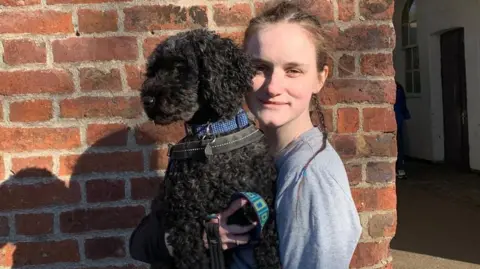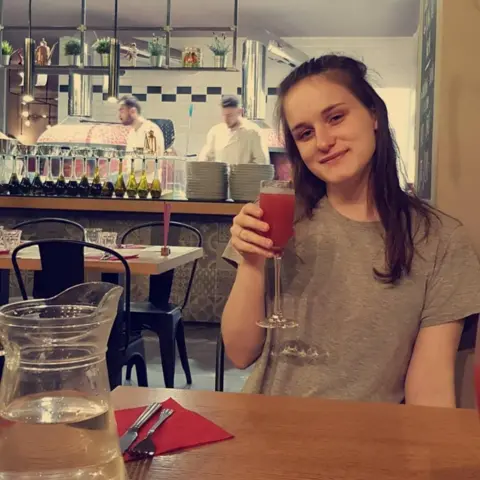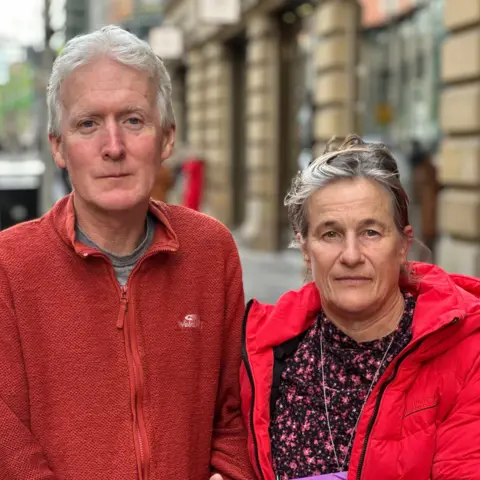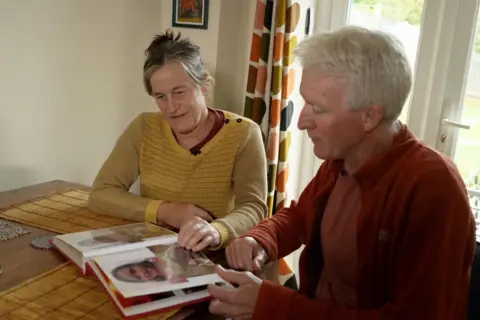Hospital neglect contributed to vulnerable woman’s death, coroner says
Alison HoltSocial affairs editor and
James MelleySenior social affairs producer
 Family handout
Family handoutWarning: The following article contains details about suicide which some may find distressing
Cerys Lupton-Jones pauses between two doorways.
One door leads into a side room in the Manchester mental health unit where she’s a patient. The other leads into a toilet.
The 22-year-old had tried to end her life just 20 minutes earlier – but no staff are seen on the CCTV footage from inside the unit.
She hesitates for about 30 seconds, walking backwards and forwards. Then she enters the toilet and shuts the door.
The next time she is seen on the footage, doctors and nurses are fighting to resuscitate her.
Cerys dies five days later, on 18 May 2022.
A coroner has concluded that some of the care Cerys was given at Park House, which was run by the Greater Manchester Mental Health NHS Foundation Trust, was a “shambles”.
Staff were meant to be checking on her every 15 minutes.
But the last recorded observation – at 15:00 – had been falsified, saying she had been seen in a corridor. CCTV shows at that point, Cerys was already in the toilet where she would fatally harm herself.
A staff member who was supposed to be looking after her has now admitted to falsifying these records.
Zak Golombeck, coroner for Manchester, said that if someone had stayed with her after the earlier attempt to take her life, what followed may never have happened. He said neglect was likely to have contributed to her death.
Campaigners are calling for an inquiry into the number of deaths at the mental health trust and believe the services are in crisis.
Greater Manchester Mental Health Trust said it “failed her that day, and we are so very sorry that we did not do more”.
 Family handout
Family handoutCerys’s parents, Rebecca Lupton and Dave Jones, describe their daughter as a loving young woman who would do anything for her friends. She was studying to be a nurse and was months away from completing her degree, with a job lined up.
She was autistic and had also struggled with her mental health since her teens.
Her family, who lived miles away in Sussex, say the pandemic and the reduction in community mental health support exacerbated Cerys’s problems.
The inquest was told Cerys had tried to take her life in the days running up to her death, spending time in A&E.
She was then readmitted to Park House and put on one-to-one observations for a short time. Later, she was supposed to be checked by staff every 15 minutes.
The inquest heard how, at about 14:35 on 13 May 2022, Cerys was found in a toilet by Mohammed Rafiq, a health support worker who had been assigned to check on her. Cerys had tried to hang herself.

Mr Rafiq and the duty nurse, Thaiba Talib, intervened.
However, the inquest heard the 15-minute observations were not then increased and staff had no proper conversation with her.
The nurse told the inquest she did not believe Cerys meant to seriously harm herself.
She told the coroner she chose not to increase observations on Cerys because she did not want her to feel punished, as she did not like being under observation.
When asked by the coroner if she should have gone with Cerys to her room after the incident and check she was safe, Ms Talib answered: “In hindsight, yes.”
Damning CCTV from inside the unit was described minute by minute in court.
It showed Cerys going into the ward garden at 14:42. The observation record, which says at 14:45 she was in her bedspace, was described by the coroner as “not accurate”.
At 14:54, Cerys walked into another toilet on the ward and closed the door.
Yet Mr Rafiq told the coroner he remembered seeing Cerys at 14:57. He wrote in the observation notes that he had seen her at 15:00 “along the corridor, looking flat-faced”. He then went on a break. In reality, Cerys was still in the toilet.
The coroner told Mr Rafiq that his recollections were wrong, and that he had “falsified” the observation records. Mr Rafiq responded: “I’m afraid so”.
Mr Rafiq said other staff had shown him how to record observations every 15 minutes, even if he hadn’t done them at that time. “That’s how they did it and that’s how I did it”, he told the court.
A new support worker took over the observations at 15:00. There was no verbal handover and, according to Mr Rafiq’s notes, Cerys had just been seen.
The CCTV shows the new support worker checking on other patients. At 15:15 she looked for Cerys.
She could be seen becoming increasingly desperate as she searched the communal areas and ran along the corridor.
At 15:19, she tried the door to the toilet, using a master key to unlock it. She found Cerys inside and immediately raised the alarm.
By that point, 25 minutes had passed since Cerys went into the toilet. She died in hospital on 18 May, five days later.
The coroner said there was a gross failure by Ms Talib to provide “basic medical attention to a person in a dependent position”.
He also found there was a culture of falsifying records on the ward.
The coroner said it was not clear what Cerys’s intention had been. In a narrative conclusion, he recorded that neglect had contributed to her death.

“I knew it was bad,” Cerys’s mother Rebecca told the BBC, “but listening to the evidence highlighted quite how poor the care was.”
Her father, Dave, says when Cerys was sectioned and taken to the hospital at the start of 2022, they believed it would keep her safe and help her get better. “In fact, it just made everything worse,” he says. “It was the wrong environment.”
“Cerys was a wonderful, wonderful young person. We feel that she would be here today if she’d been given better care by Manchester Mental Health Trust,” Rebecca said outside court, after the coroner gave his conclusion.
Dave described the disbelief and anger as difficult to put into words. “We need more funding for mental health services, more staff, better training and much better oversight.”
Immy Swithern was a patient at the same time as Cerys. They became close friends. She says they tried to make the best out of a bad situation and would talk all day.
She also claims some staff regularly failed to carry out 15-minute safety checks, so they tried to look out for each other.
“I was there to get better, and I was there to have help with that,” she says. “Instead, I was constantly checking on people. On that ward, I think that is the most scared I’ve ever felt in my life.”
Park House mental health unit has since closed. It was replaced by a new £105.9m hospital in November 2024.
The NHS trust said it had “significantly improved” its provision of care and it was grateful to the coroner for “acknowledging the work that has been done to prevent something of this nature from happening again”.
But campaigners claim mental health services in Manchester are in crisis.
Responding to Tuesday’s inquest verdict, the Communities for Holistic, Accessible and Rights-based Mental Health (CHARM) group, says: “It is devastating to hear of yet another young person losing their life as a result of neglect and poor care.”
The group says it is due to meet Mayor of Greater Manchester Andy Burnham this week to call for a statutory inquiry into the deaths and the financial crisis in the city’s mental health services.
In October 2022, five months after Cerys death, an undercover BBC panorama programme exposed bullying and the mistreatment of patients at the medium secure Edenfield centre, which was also run by GMMH.
As a result, an independent review was commissioned by the NHS and published in 2024.
It found a “closed culture” at GMMH. It also raised concerns about the number of deaths by ligature.
In 2022, 19 people took their own lives by hanging on mental health units in the UK, five were GMMH patients, the trust itself said that meant it had 26% of all such deaths in the whole country.
If you are suffering distress or despair, details of help and support in the UK are available at BBC Action Line.


